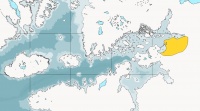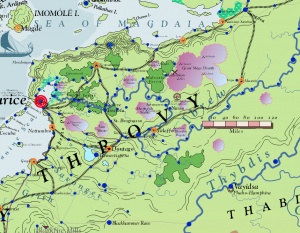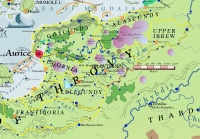Difference between revisions of "Throvy"
Trismegistus (talk | contribs) m (→Lelegundy) |
Trismegistus (talk | contribs) m (→Agriculture) |
||
| Line 17: | Line 17: | ||
=Agriculture= | =Agriculture= | ||
| − | Throvy is abundant in arable land, despite the presence of the Throe Wastes. Farmers raise cattle, grain, grapes, olives, and vegetables. The woodlands are used for timbering and Throvy produces excellent furniture and other wooden goods. | + | Throvy is abundant in arable land, despite the presence of the Throe Wastes. Farmers raise cattle, grain, grapes, olives, and vegetables. The woodlands are used for timbering and Throvy produces excellent furniture and other wooden goods. Throvian wines are world-famous. |
=Government= | =Government= | ||
Revision as of 01:14, 20 January 2015
Throvy today is an over-province of the Aurician Empire and incorporates the provinces of Goscundy, Alascundy, Ugornia, Brawthorn, Uthragunia, Lelegundy, and Frantigoria, and Upper Ibrew, all lands between the upper Ibrew River and the Pallathantic Sea. The climate is cool in the winter with little or no snow and warm and muggy in the summer.
The rich history of Throvy tells of Midringian Tribesmen, uhlak invasions from the west, Midretassene and Yophenthean conqueror, each in their turn, vast tracts of land scarred with magical pollution during the Middle Ages of Chaos, and titancraft vessels of air plying its skies from Imperial Aurice. Throvy rests in western Asdauria to the south of Erserce across the Sea of Magdaia and to the east of Corundy. It is bounded to the southeast by the Thybdis River.
Etymology
The name Throvy comes from the Thracian Language and is source of the name of the land in Medibgóëse and other languages. The historic name is 'Jecubia' and originates from the Kalaman name, Jakubya.
Magdeology
Woods of poplars, oaks, and maples cover stretches of land along with great expanses of farmland and pasturage. Bimbhari trees can be found most everywhere, but especially in southern and western Throvy. The soil is somewhat rich, especially along some parts adjacent to the Ibrew River.
Unique to Throvy in the whole world are the witchlands or the Throe Wastes. On the map above, these are depicted as pinkish regions. The Throe Wastes arose during the Middle Ages of Chaos when chaos wizards fought the Brasen Horde, one another, and even the gods of Chaos themselves in the Anarch Wars, 2166 to 2224. They unleashed powerful magics that scarred the land, rendering it impossible for most plants to grow by warping and draining the local ambient magic. The fear of Chaos magic rests in the subconscious fabric of Throvy even three centuries after the Fifth Isbajath liberated the land.
Throvy is largely agricultural and the economic gap between the farmers and peasants of Throvy and the rich city-dwellers of the imperial city is not lost on visitors to both. The individual provinces of Throvy enjoy the power of their own freely elected parliament to administer internal affairs. Grand Duke Stalcast Bijäl in the late twenty seventh century decreed all serfs in Throvy to be free. Despite this reform, Throvy is still a poor land in many ways.
Agriculture
Throvy is abundant in arable land, despite the presence of the Throe Wastes. Farmers raise cattle, grain, grapes, olives, and vegetables. The woodlands are used for timbering and Throvy produces excellent furniture and other wooden goods. Throvian wines are world-famous.
Government
The freemen of each province of Throvy may elect a local aristocrat to represent his district in the provincial parliament which has great power over all internal affairs of the province. Some political dissidents are agitating for the patrician requirement to be removed for selection to the parliament, while others wish to have a second house in the parliament with commoners chosen only by commoners. The capital of the empire, the City of Aurice, is ruled by magistrates appointed by the Noble Senate with some local management in the stewardship of the viceviles.
Provinces of Throvy
Alascundy
History and tales of Alascundy before the Anarch Wars tell of its green pasturage and beetling forests. During the Anarch Wars, great tracts of forest were destroyed by chaos magics and are now the immense stretches of the Great Mage Dearth. A smaller Throe Waste rests in northwestern Alascundy called Airdred's Waste. The Malvatic Forest occupies western Alascundy and is the surviving remnant of a greater forest that formerly covered most of Alascundy. Northern Alascundy is crossed by the eastern Igorian Mountains before ones comes to the Sea of Magdaia.
The provincial sea of Alascundy is Lexa. Rhoguzzo Grenzo and Tremonia are important cities of the coast. The Throe Wastes of Alascundy are home to several lost cities, Banjavit, Vilangril, Aszhrafa, Eszhuna, and Hars.
Alascundy is not heavily populated due to the presence of the Throe Wastes. It is rural at best and wild at worst, save for the cities along the northern coast. Alascund bards claim the land is the final resting place of Airdred the Wily.
Brawthorn
Frantigoria
Frantigoria is a land of rolling green hills, bosques, scenic towns, and world-famous wines. The province has a stretch of coastline along the Addanine Sea. The provincial seat in Salunca. The southern boundary of Frantigoria pass through the Blackfire Hills, a curious land sometimes compared to the Amosgire Hills. Most of the River Savonger passes through the province of Frantigoria. The province is the westernmost province of Throvy and shares borders with the Aurician province of Lower Zamir and the Republic of Johaulia. The wine festivals of Salunca draw high-profile visitors from as far afield as Amerzcelindo and Hœrnect.
Goscundy
A historic region of northwest Throvy, Goscundy is closest to the isles of the City of Aurice and proud of its ancient roots and culture. Goscundy is politically a province in the Over-Province of Throvy. Goscundy like the other provinces in Throvy enjoys its own autonomous parliament.
Goscundy's north coast is edged east to west with the precipitous Igorian Mountains against the sea. These tend to avert the harshness of storms from northern climes. The weather is somewhat humid due to proximity to the sea. The winters are mild with little or no snow and the summers can be rather warm at times.
The principle city of Goscundy is Nestrabonia. Other cities include Lexicle, Mondorigor, Cantira, Taltera, Scloye, Trecoria, Magetown, Uscolo, and Cormantissa. The imperial City of Aurice is independent from the provinces, although historically it shares Goscundian culture.
Bards of Goscundy are renown for their poems exulting the history of the land, especially Airdred the Wily and the victories of the Incarnandist Warriors of the Fifth Isbajath, especially favoring the valiant Gidhoniel kab S'ephah and his defeat of wicked Prince Ulcanov of the Shattered Waters.
Lelegundy
Lelegundy is a province in southern Throvy. Lake Vostar, the largest lake in Throvy rests in Lelegundy. Lake Camunda also rests in Lelegundy. The provnicial capital of Lelegundy is Dontago. Other cities in Lelegundy include Zarzafrala, Hemertispera, Zibustri, Strona, and Maba Luva. Large hills cover northern Lelegundy. Lelegundy has a mild, mediterranean climate and is known for agriculture and marble quarries. Eastern Lelegundy has many vineyards and is free of Throe Wastes.
Ugornia
Upper Ibrew
Uthragunia
Throe Wastes
The horrendous wars and chaos magics of the Middle Ages created vast zones of warped magic in the great plains east of the present-day Aurician Empire. These vast zones of unpredictable and vacuous magic lie for the most part west of the great Thybdis River. The greatest Throe Waste is called the Great Mage Dearth and covers about a third of the province of Alascundy. Other Throe Wastes of great size are the Ulcanosto Waste, the Van Waste, the Shepherds Waste, the Durstnot Waste, the Hurstless Waste, and Airdred's Waste.
Most of the witchlands as they are also known in Throvy were created during the Anarch Wars (begun 2415 IR).
A typical throe waste is stripped of most vegetation with a remnant of sand or dirt and crops of stunted plants. Few animals will enter or live in a throe waste and even most birds will fly around it.
The barren state of a throe waste is harmless compared to its magical corruption and imbalance. Most often, spellcasters find it impossible to cast a spell of any significance, for the panstream runs nearly dry. Less frequently, magical storms of intense power ravage the throe waste, wreaking havoc on persons, creatures, and titancraft which are sensitive to magical energy. Even everyday living creatures will suffer debilitating sickness and malnourishment after several days of exposure to a throe waste.


